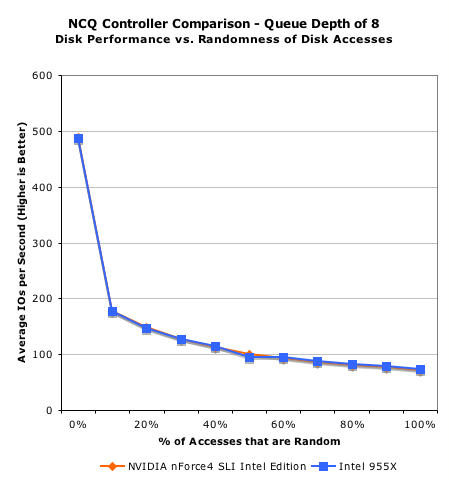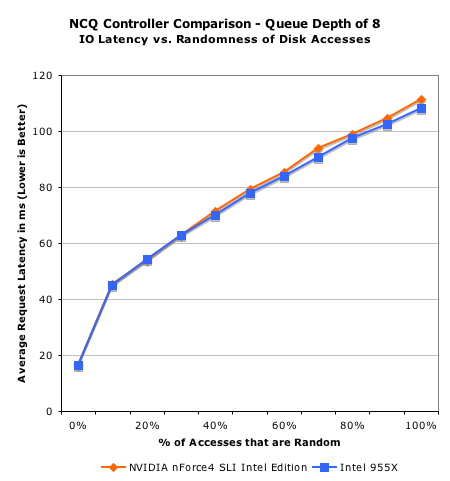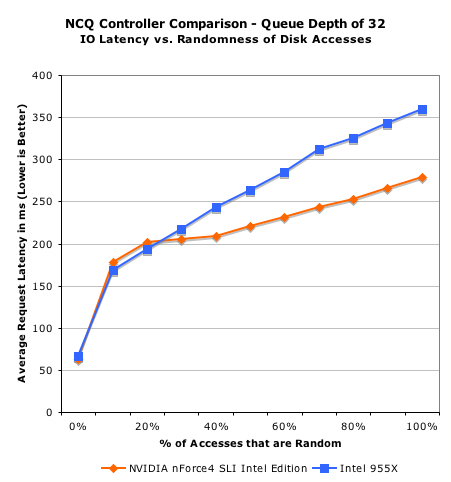Dual Core Intel Platform Shootout - NVIDIA nForce4 vs. Intel 955X
by Anand Lal Shimpi on April 14, 2005 1:01 PM EST- Posted in
- CPUs
SATA Controller Performance
Both NVIDIA and Intel offer support for NCQ in their SATA controllers, and given our recently renewed interest in NCQ performance, we decided to find out if there were any performance differences between the two SATA controllers. However, as we've found in the past, coming up with tests that stress NCQ is quite difficult. Luckily, there is a tool that works perfectly for controlling the type of disk accesses that you want to test: iometer.
An Intel developed tool, iometer allows you to control the size, randomness and frequency, among other things, of disk accesses, and measure performance using data generated according to these specifications. Given that NCQ truly optimizes performance when disk accesses are random in nature, we decided to look at how performance varied according to what percentage of the disk accesses were random. At the same time, we wanted the tests to be modeled on a multitasking desktop system, so we did some investigation by setting up a computer and running through some of our multitasking scenarios on it.
What we found is that on modern day hard drives, the number of outstanding IOs (IO Queue Depth) is rarely above 10 on even a moderately taxed system. Only when you approach extremely heavy multitasking loads (heavier than anything that we've ever tested) do you break into queue depths beyond 32. So, we put together two scenarios, one with a queue depth of 8 and one with a queue depth of 32 - the latter being more of an extreme condition.
In each scenario, we sent the drives a series of 64KB requests, 75% of which were reads, 25% were writes; once again, derived from monitoring our own desktop usage patterns.
We then varied the randomness of disk accesses from 0% (e.g. 100% sequential) up to 100% (0% sequential reads/writes). In theory, the stronger NCQ controllers will show better performance as the percentage of random accesses increases. We reported both Average IOs per Second and average IO response time (how long accesses took to complete on average):

With a queue depth of 8, the two SATA controllers offer virtually identical performance.

Looking at latency, Intel actually offers a very slight performance advantage here - nothing huge, but it's definitely there.
The results get much more interesting as we increase the queue depth to 32:

Here, NVIDIA starts to pull away offering close to a 20% increase in average IOs per second as the access patterns get more random (e.g. as more applications running at the same time start loading down the hard disk).

What's truly impressive, however, is the reduction in average response time - up to a 90ms decrease in response time, thanks to NVIDIA's superior NCQ implementation.
But stepping back into reality, how big of a difference NVIDIA's NCQ implementation makes depends greatly on your usage patterns. Heavy multitaskers that are very IO bound will notice a performance difference, while more casual multitaskers would be hard pressed to find any difference. For example, Intel was actually faster than NVIDIA in our gaming multitasking scenarios from our dual core investigation.










96 Comments
View All Comments
xsilver - Thursday, April 14, 2005 - link
oh and before when you were arguing about heat --- if you didnt understand... let me translate the graph segagenesis providedamd 64 3500 at load = 114w
intel 550, 3.4ghz /load = 207w
that's close to DOUBLE power consumption with similar performance/price characteristics.
xsilver - Thursday, April 14, 2005 - link
#54I remember reading amd's 3 year roadmap right here on AT.... maybe you missed it
3 year roadmaps aren't very good anyways, they provide no real hard information.... what are you worried that amd isn't going to exist in 3 years???
what AT people here are arguing is about performance... now you have jumped from heat output to spelling to performance and now to company profile... please be concise
Questar - Thursday, April 14, 2005 - link
"The only defense I imagine he could possibly conjure up right now is currently in the market there is the "Nobody got fired for buying Intel" mentality where companies and such are wary of trying non-Intel products mainly because... Dell and other major manufacturers wont offer it in any quantity."Actually there are two reasons:
1) Qualification costs. it can be easy to drop $150k to qualify a new platform.
2) Product longevity. Change is very expensive to large corporations. Anything we make a commitment to buy must have a lifespan of at least 18 months from the date we qualify the product. We also must be comfortable with the companies 3 year product roadmap. So far there are no teir one vendors that have AMD product lines that meet these requirements.
Questar - Thursday, April 14, 2005 - link
NVIDIA changed the spelling of their name from nVidia to NVIDIA a few years ago, have a look at NVIDIA's home page for confirmation - http://www.nvidia.com/page/companyinfo.htmlQuestar: NVIDIA is the correct corporate capitalization of the company. I actually don't think I've ever seen it spelled "nVidia".
I stand corrected. Thank you.
glennpratt - Thursday, April 14, 2005 - link
I think you mean you disagree with his first statement, since his last statement was about DDR2. Personally, I assume reviews on this site are talking to me (PC enthusiast) and not businesses (except reviews which explicitly state otherwise which are few and far between here). In that context, Anand has a point.KristopherKubicki - Thursday, April 14, 2005 - link
Questar: NVIDIA is the correct corporate capitalization of the company. I actually don't think I've ever seen it spelled "nVidia".Kristopher
Motley - Thursday, April 14, 2005 - link
Perhaps it should have been worded differently like... offered performance benefits that have only yet to be realized. But as worded, it is misleading and incorrect. Obviously, I read your site often, and I have come to expect technical correctness in what you write ;-)That said, I still would have to disagree with your last statement. Where companies purchase and keep PC's around for 3+ years (OMG, I wish we got rid of PC's in 3 years), the ability to purchase PCI-E when it came out knowing that we could upgrade them to iSCSI, etc in the future *IS* a very tangable benefit. At home, it's a different story, where my motherboard changes with every major change (or every other as money permits).
BaronVonAwesome - Thursday, April 14, 2005 - link
You have to be leery of anyone who resorts to juvenile symantics in an argument. When Questar derided another person for using the word "worthless" to describe Intel, you had to ignore him. Obviously, "worthless" wasn't meant literally. That's one of the wonders of the English language, the way it evolves, with words taking on more subtle meanings through the gradual societal acceptance of colloquialisms and slang. Words like "worthless" also lose their qualitative and quantitative qualities through this evolution...depending on how the word is used of course. Generally, when people resort to literal symantics, they feel like they are losing the argument. Reminds me of when Bill Clinton questioned the definition of the word "is." Questar's back was against the wall, I guess.glennpratt - Thursday, April 14, 2005 - link
On another note will there be a non-SLI version of the nF4 Intel Ed.?glennpratt - Thursday, April 14, 2005 - link
Questar - This may have been said before, but I didn't read this whole thread.Reviews are generally filled with opinion, it's the nature of the beast. If you wanted an Intel white paper well this isn't the place for it. If you've taken a high school level english class then you should be quite capable of determining opinion from fact in common english.